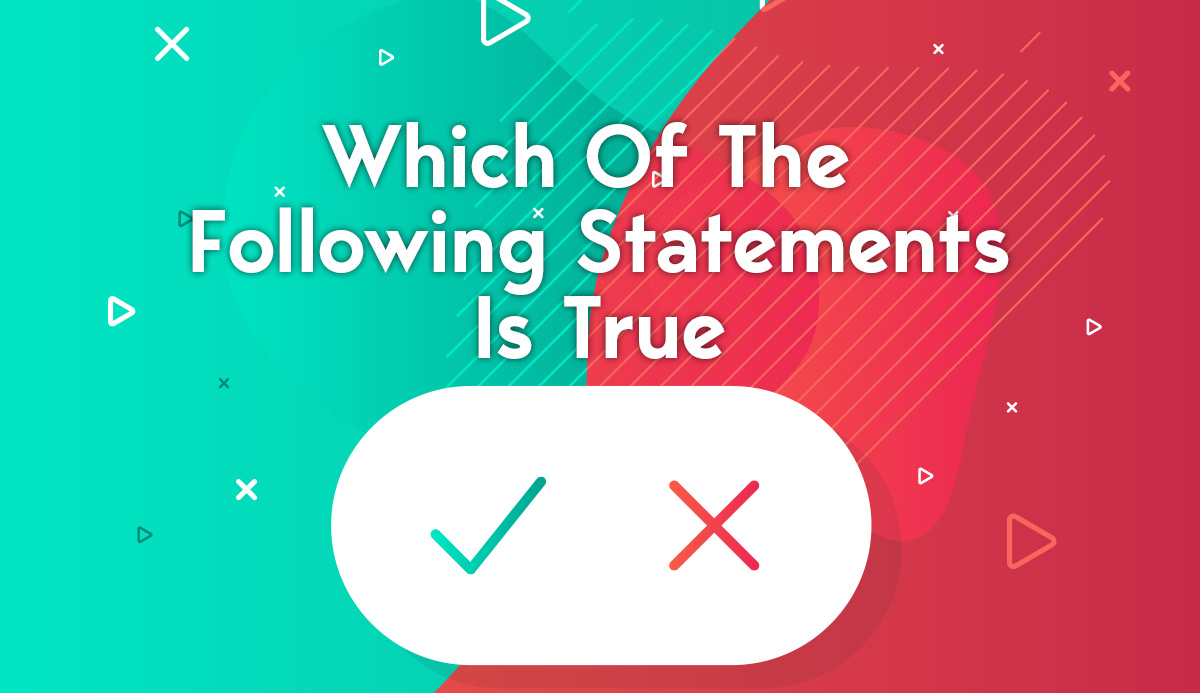In a world filled with information and opinions, it can be challenging to determine which statements are true. Our ability to distinguish fact from fiction is crucial for making informed decisions and understanding the world around us. In this article, we will explore the nature of true statements, evaluate their role in different contexts, address common misconceptions about truth, delve into the process of verifying statements, and examine the impact of true statements on decision-making.
Understanding the Nature of True Statements
Before we can evaluate the truthfulness of statements, it is important to understand what makes a statement true. Truth is not merely a matter of personal opinion; it is an objective state of affairs that accurately represents reality.
Logic plays a significant role in determining the truth of statements. By applying logical reasoning, we can assess the validity of an argument and determine whether its premises are true or false. Logic provides us with a framework for distinguishing between sound and unsound assertions.
Factual accuracy is another critical aspect of true statements. To be true, a statement must align with the objective facts of the matter. Factual accuracy ensures that information is reliable, trustworthy, and grounded in reality.
When evaluating the truthfulness of a statement, it is essential to consider the context in which it is made. Context can greatly influence the interpretation and validity of a statement. For example, a statement that may be true in one situation may not hold true in another. Understanding the context helps us determine whether the statement accurately reflects reality in a given scenario.
Furthermore, the use of evidence and supporting information is crucial in determining the truth of a statement. A well-supported statement is more likely to be true than one without any evidence. Evidence can come in various forms, such as empirical data, expert opinions, or historical records. The presence of reliable evidence strengthens the credibility of a statement and increases its chances of being true.
It is also important to consider the source of the statement when assessing its truthfulness. The credibility and expertise of the source can significantly impact the reliability of the information provided. Statements made by reputable experts in a particular field are generally more trustworthy than those made by individuals with no expertise or questionable motives.
Additionally, the consistency of a statement with other established truths is a factor to consider. If a statement contradicts well-established facts or principles, it is less likely to be true. Consistency with existing knowledge and evidence is an important criterion for determining the truthfulness of a statement.
In conclusion, determining the truthfulness of a statement involves considering various factors such as logical reasoning, factual accuracy, context, evidence, source credibility, and consistency with established truths. By carefully evaluating these aspects, we can better assess the validity and reliability of statements, ensuring that our understanding of reality is based on accurate and truthful information.
Evaluating Statements in Different Contexts
The truth of statements can vary depending on the context in which they are made. In science, true statements are based on empirical evidence and are subject to rigorous testing and scrutiny. Scientific truths are constantly evolving as new discoveries are made and theories are refined.
For example, consider the statement “All living organisms require oxygen to survive.” In the context of biology, this statement is generally true. Through extensive research and experimentation, scientists have found that the majority of living organisms on Earth do indeed require oxygen for their survival. However, there are exceptions to this rule, such as certain anaerobic bacteria that can survive in oxygen-free environments. These exceptions highlight the importance of considering the specific context in which a statement is being evaluated.
Similarly, in mathematics, true statements are based on logical principles and axioms. Mathematical truths are absolute and do not change over time. They serve as the foundation for various scientific and technological advancements.
Take, for instance, the statement “The sum of the angles in a triangle is always 180 degrees.” This statement holds true in the context of Euclidean geometry, which is the most commonly studied form of geometry. Through rigorous mathematical proofs, it has been established that the sum of the angles in a triangle is indeed always 180 degrees. However, in non-Euclidean geometries, such as spherical or hyperbolic geometries, this statement does not hold true. In these alternative geometries, the sum of the angles in a triangle can be greater or less than 180 degrees, depending on the curvature of the space. This demonstrates how the context of the mathematical system being used can greatly influence the truth of a statement.
In philosophy, true statements are often subjective and open to interpretation. Philosophical truths explore complex concepts such as morality, existence, and consciousness. They rely on logical reasoning and philosophical discourse to reach a deeper understanding of the world.
Consider the statement “Beauty is in the eye of the beholder.” This statement reflects the subjective nature of aesthetic judgments. What one person finds beautiful, another may not. Philosophers have engaged in extensive debates and discussions about the nature of beauty, attempting to understand its underlying principles and subjective qualities. These philosophical inquiries have led to various theories and perspectives on beauty, highlighting the diverse and contextual nature of truth in philosophy.
Furthermore, philosophical truths often delve into existential questions, such as the nature of reality and the meaning of life. These inquiries are highly subjective and can vary greatly depending on individual perspectives and cultural backgrounds. Philosophers employ critical thinking and logical reasoning to explore these profound questions, recognizing that there may not be a definitive answer that applies universally to all contexts.
In conclusion, evaluating statements in different contexts is crucial to understanding the nature of truth. Scientific truths rely on empirical evidence and undergo constant refinement, while mathematical truths are based on logical principles and remain constant across different contexts. Philosophical truths, on the other hand, are subjective and open to interpretation, exploring complex concepts and existential questions. By considering the specific context in which a statement is made, we can gain a deeper appreciation for the complexities of truth and knowledge.
Common Misconceptions about Truth
One common misconception about truth is the influence of bias on our perception of it. Our preconceived notions, beliefs, and personal experiences can color our interpretation of information, leading us to accept or reject statements based on our existing worldview. It is important to recognize and challenge our biases in order to approach truth objectively.
For example, imagine a group of people discussing a controversial topic such as climate change. Each individual in the group may have their own biases based on their political beliefs, personal experiences, or cultural background. These biases can affect how they interpret and accept information related to climate change. Someone with a conservative worldview may be more inclined to reject scientific evidence supporting climate change due to their political beliefs, while someone with a liberal worldview may be more inclined to accept it. These biases can hinder our ability to arrive at an objective truth.
Another danger is misinformation. False or misleading information can spread rapidly, particularly in our digital age. It is crucial to verify the accuracy of statements before accepting them as true. Engaging in critical thinking and fact-checking can help prevent the spread of misinformation and promote a more informed society.
In today’s interconnected world, information can be disseminated quickly through social media platforms, online news outlets, and other digital channels. While this has its advantages, it also opens the door for the rapid spread of misinformation. A single false claim can be shared and amplified by thousands or even millions of people within minutes, leading to a distorted perception of truth. This phenomenon is often referred to as the “echo chamber effect,” where individuals are exposed only to information that aligns with their existing beliefs, reinforcing their biases and creating an environment where misinformation can thrive.
To combat this, it is essential for individuals to develop critical thinking skills and actively seek out diverse perspectives. By exposing ourselves to different viewpoints and engaging in thoughtful analysis, we can better discern between accurate information and falsehoods. Fact-checking websites and reputable news sources can also serve as valuable resources in verifying the accuracy of statements.
Furthermore, the concept of truth itself can be complex and multifaceted. In some cases, there may be multiple truths or varying degrees of truth depending on the context. For instance, in a court of law, the truth may be determined based on the evidence presented and the legal standards applied. However, this truth may not necessarily align with the emotional truth experienced by the individuals involved in the case.
Additionally, the perception of truth can be influenced by societal norms and cultural values. What may be considered true in one culture or society may not hold the same weight in another. This highlights the importance of understanding and respecting different perspectives when discussing truth.
In conclusion, the influence of bias on our perception of truth and the spread of misinformation are common misconceptions that can hinder our ability to arrive at an objective understanding of reality. By recognizing and challenging our biases, engaging in critical thinking, and verifying the accuracy of statements, we can strive towards a more informed and nuanced understanding of truth.
The Process of Verifying Statements
Verifying statements involves utilizing various tools and techniques to assess their truthfulness. Fact-checking organizations play a crucial role in verifying statements and debunking falsehoods. These organizations meticulously analyze claims, cross-reference information from reliable sources, and provide evidence-based assessments.
Evidence is paramount in the process of verifying statements. Whether it is in the form of scientific research, statistical data, expert opinions, or firsthand accounts, evidence strengthens the credibility of a statement. By scrutinizing and validating evidence, we can make more reliable determinations of truth.
The Impact of True Statements on Decision Making
True statements have a significant impact on decision making, both in personal and professional contexts. When making personal decisions, relying on true information ensures that our choices are well-informed and aligned with reality. Making decisions based on falsehoods can lead to undesirable outcomes or missed opportunities.
Similarly, in professional settings, the accuracy of statements is crucial for effective decision making. Leaders and decision-makers need to rely on true information to develop strategies, allocate resources, and assess risks. False or misleading statements can have detrimental consequences for organizations and the individuals involved.
In conclusion
Ultimately, determining which statements are true requires critical thinking, a commitment to factual accuracy, and a willingness to challenge our own biases. By understanding the nature of true statements, evaluating their context, addressing common misconceptions, engaging in the process of verification, and acknowledging the impact of true statements on decision making, we can navigate the vast sea of information and make more informed choices.



